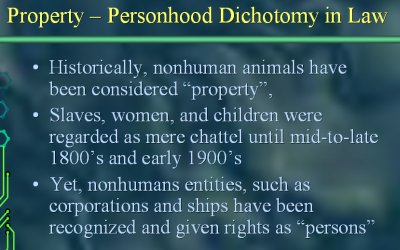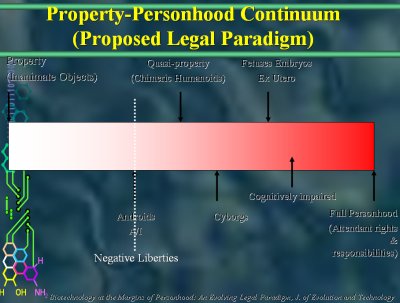The Tao of Personhood:
The Yin and Yang of the Property-Person Continuum
Linda MacDonald-Glenn, J.D.
Page 3 of 3
I am not too worried about that case though because there is  this case in 1922 that I find to be a fascinating case, the Jack-O-Lantern case [1]. A ship had been rebuilt pretty much from stem to stern. I think that the spine and the hull was still the same. The question that faced the Court was whether rebuilding the vessel changed the identity of the vessel. The Court said,
this case in 1922 that I find to be a fascinating case, the Jack-O-Lantern case [1]. A ship had been rebuilt pretty much from stem to stern. I think that the spine and the hull was still the same. The question that faced the Court was whether rebuilding the vessel changed the identity of the vessel. The Court said,
“This court has not undertaken and will not now essay to announce rigid definitions of repairs and new construction, we do not accept the suggestion that the two things can be accurately differentiated by consideration of the ultimate use to which the vessel be devoted.”
The Supreme Court held that the identity remained the same. This raises a fascinating question of: How much of yourself can you replace and still retain your identity? This case seems to intimate that you can replace quite a bit of yourself and still be you and still retain your identity.

Image 8
While the law is equipped to hold autonomous individuals culpable for his or her actions, well, it is not so well designed for systems. Perhaps you have heard the expression that the law operates in a rear-view mirror -- that often this is not taken care of until after the fact. It is exciting to be here today to try to anticipate this as we did with the Colloquium on the Law of Outer Space. We will start getting into questions about whether or not there a distinction between the rights of the individual and the rights of a person. The person-property continuum will continue to evolve.
One of the things that we will continue to discuss is whether using a dichotomy or a continuum, whether the rights and responsibilities should if an individual may change when the performance is enhanced by machine or other technology. How many people are held responsibility for that, for the action of what becomes the system rather than just an individual.

Image 9 [Click above for larger image]
I have proposed a legal paradigm which is subject to discussion and change because at one end of the spectrum we have full personhood with attendant rights and responsibilities with other entities such as fetuses, ex utero; the cognitively impaired, cyborgs, chimerac humanoids [2], androids with a basic negative liberty baseline, that is the right not to be destroyed without due process. However; this is a paradigm that has as many perils as it has promises because it's certainly not my intention to create a slave race. Nor, do I think that this paradigm should be used to create a race of sub-humans in order to perhaps undesirable work as Joseph Fletcher. The idea is to give a basic minimum of negative liberties.
As different forms of chimeras, cyborgs, and AI are created in the technical environment, the courts will be the ones who determine (unless the legislature does first) where these creations fall on the continuum of personhood.
The beautiful fractal imagery of the Yin and the Yang is supposed to be representative of going beyond duality, going beyond the notion that we have to think it's either A or B; it can be A plus B; it can be A overlapping with B; or C or D or whatever. To look at the issue of personhood from a holistic, interdependent perspective, one of the things that I think is so important to be wary of is not necessarily be imposed this very sort of male-dominated hierarchal perspective, that emotions do play a very important role in what makes a person. Instead of looking at it as a very traditional hierarchal, that we look at it from a more holistic, interdependent approach.
I propose a common lexicon but it sounds like it overlaps with David Koepsell’s idea for ontology. It drives me nuts when policy makers use the word "autonomous." When the military talks about autonomous robots right now that is very different from what we mean by autonomy, certainly in bioethics. I would like us to consider the possibility of legal reform in creation of specialized science courts where the judges will have ongoing education and training to prepare with these new legal issues and categories that arise from these emerging technologies.
Moreover, I like what Ray Kurzweil [3] had to say about this, too, that, "Technology has always been a double-edged sword, empowering both our creative and our destructive natures." There is something else that he said which I admired recently that I think is so true, when he was asked about the evolution of AI, he said, "It's not going to be us versus them because we will be them." It will be a merger. As long as we try to strive for looking for common ground for commensurability, we can be successful. If you want to fight, anybody can fight, that's easy. That is very sub-human nature, but the important thing is that I think we have an obligation to do is what separates, if there is anything that separates us humans, is the notion that we have an obligation and a responsibility. It is our notion of stewardship to all living beings, to sentience and to our planet.
I would like to conclude with the Yin and the Yang, remembering that there are so many different ways of looking at this problem and different ways of approaching it, and that we should keep our minds open and embrace this from every different perspective.Footnotes
1. Jack-O-Lantern case – THE JACK-O-LANTERN, 258 U.S. 96 (1922) 258 U.S. 96
http://caselaw.lp.findlaw.com/... February 1, 2008 4:33PM EST
2. Chimera – n. [NL, genus name , fr. L, chimera] (1804) : any of a family (Chimaeridae) or marine cartilaginous fishes with a tapering or thread-like tail and usu. No anal fin. chimeric, chimaerism chiefly Brit var of CHIMERIC, CHIMERISM.
Merriam-Webster’s Collegiate Dictionary . Massachusetts: Merriam-Webster Incorporated, 2005: 214.
3. Ray Kurzweil - (born February 12, 1948) is an inventor and futurist. He has been a pioneer in the fields of optical character recognition (OCR), text-to-speech synthesis, speech recognition technology, and electronic keyboard instruments. He is the author of several books on health, artificial intelligence, transhumanism, technological singularity, and futurism.
http://en.wikipedia.org/wiki/Ray_Kurzweil February 5, 2008 9:52AM EST
Bio
 Linda MacDonald-Glenn, J.D., LLM, is affiliated with theAlden March Bioethics Institute at Albany Medical Center and in the University of Vermont’s College of Nursing and Health Sciences, Burlington, VT. Formerly a fellow with the Institute of Ethics of the American Medical Association, and current Women’s Bioethics Project Scholar, Linda MacDonald Glenn’s research encompasses the legal, ethical, and social impact of emerging technologies and evolving notions of personhood. In addition to her current educational, lecture and consultation work, Linda is writing several articles regarding evolving notions of personhood and maintains an ongoing blog (www.womensbioethics.blogspot.com) as a Women’s Bioethics Project Scholar.
Linda MacDonald-Glenn, J.D., LLM, is affiliated with theAlden March Bioethics Institute at Albany Medical Center and in the University of Vermont’s College of Nursing and Health Sciences, Burlington, VT. Formerly a fellow with the Institute of Ethics of the American Medical Association, and current Women’s Bioethics Project Scholar, Linda MacDonald Glenn’s research encompasses the legal, ethical, and social impact of emerging technologies and evolving notions of personhood. In addition to her current educational, lecture and consultation work, Linda is writing several articles regarding evolving notions of personhood and maintains an ongoing blog (www.womensbioethics.blogspot.com) as a Women’s Bioethics Project Scholar.